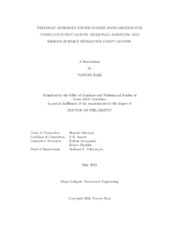| dc.description.abstract | In the context of computational fluid dynamics (CFD), accurate simulation of turbulent flows remains a challenging field of research. Although direct numerical simulation (DNS) and large-eddy simulation (LES) are able to capture the turbulent flow features to a great extent, they are not viable for complex engineering flows. On the other hand, Reynolds-averaged Navier-Stokes (RANS) models involve too many simplifying assumptions, making them inadequate to capture complex flow features. Variable resolution (VR) bridging methods such as the Partially-averaged Navier-Stokes (PANS) model fill the gap between these two limits by allowing a tunable degree of resolution from RANS to DNS.
The goal of this dissertation is to investigate the the PANS model capabilities in providing significant improvement over RANS predictions at slightly higher computational expense and producing LES quality results at significantly lower computational cost. This research work is divided into three main studies. The objective of each study is: (i) investigate the model fidelity at a fixed level of scale resolution (Generation1-PANS/G1-PANS) for smooth surface separation, (ii) derive the PANS closure model in regions of resolution variation (Generation2-PANS/G2-PANS), and (iii) validate G2-PANS model for attached and separated flows.
The key contributions of this dissertation are summarized as follows. The turbulence closure model of varying resolution, G2-PANS, is developed by deriving mathematically-consistent commutation residues and using energy conservation principles. The log- layer recovery and accurate computation of Reynolds stress anisotropy is accomplished by transitioning from steady RANS to scaled resolved simulations using the G2-PANS model. This represents a major advantage of PANS as most other hybrid approaches encounter significant errors in the log-layer region. Finally, several smooth-separation flows on the NASA turbulence website have been computed with high degree of accuracy at a significantly reduced computational effort over LES using the G1-PANS and G2-PANS models. These results along with strong theoretical foundations demonstrate that PANS has the potential to become a transformative CFD approach for scale-resolving turbulence simulations. | en |


